A certificate of insurance is a snapshot of an insurance program for your business summarizing the coverage dates, carrier(s), policy type(s) and limits for liability policies. They can include wording for special conditions like an additional insured or a waiver of subrogation. Collecting, reviewing, and tracking these documents is an important step in the risk management of an organization. Here's some tips for Certificate of Insurance Management Process for Sub-Contractors and Independent Contractors: Read more here!

Insurance terminology can be confusing for the most seasoned business owner and there are so many terms that seem to intertwine, sound similar or are often abbreviated and one can become confused about the meaning of these terms. We’re here to clear up some of your confusion.
Certificate of Insurance
A certificate of insurance is simply a snapshot of a policy, like a photograph of the main points of a policy on any given day. Ah yes! Because things can change, a policy can cancel for non-payment or other changes could have been made to a policy. A certificate of insurance starts with the policy holder; this is the entity or individual in whose name an insurance policy is held and covers for liability. The certificate will reflect the information on that policy holder’s policy.
Certificate Holder
A certificate holder is the one who may be requesting the snapshot of the policy holder’s insurance coverages. Many times this is because the policy holder is delivering a service or there may be a contract agreement requiring insurance. A certificate holder does not need to be endorsed onto a policy; the certificate is simply a reflection of the policy itself. If the holder wants to have some additional interest in the policy holder’s insurance policy then the policy must be endorsed and a certificate can also reflect that endorsement.
Additional Interest
Is additional insured the same as additional interest you ask? The answer is sort of, but not really. An additional interest is someone that has an interest in making sure that the policy holder maintains insurance coverage. This could be a landlord making sure his tenant is insured for liability or it could be a bank looking to ensure property coverage is maintained on a building for loan securement. This is a general term and you’re more likely to see an additional interest in the form of an additional insured in the case of liability or as a loss payee or mortgagee in the case of property coverage.
Additional Insured
An additional insured extends liability insurance coverage beyond the named insured to include other individuals or groups. An additional insured endorsement protects the additional insured under the named insured's policy allowing them to file a claim if sued. It covers legal claims that may arise from the work of a sub-contractor and allows a layer of protection for the one hiring out their work. Some policies include a blanket additional insured in the policy but be aware that most of these forms require that there be a written contract in place for this additional insured endorsement to apply. The additional insured form should always be attached to the certificate of insurance when it applies.
Tips for efficient processing of your certificate requests
• Always include the full legal name and address of the entity requesting the certificate
• Be aware of what the requester’s contract requirements for insurance are – look at the contract and send the insurance requirements to your agent to review
• Understand why someone is asking you for proof of insurance and if you’re not sure talk to your agent.
You might also like...
Sign up for our newsletter.





